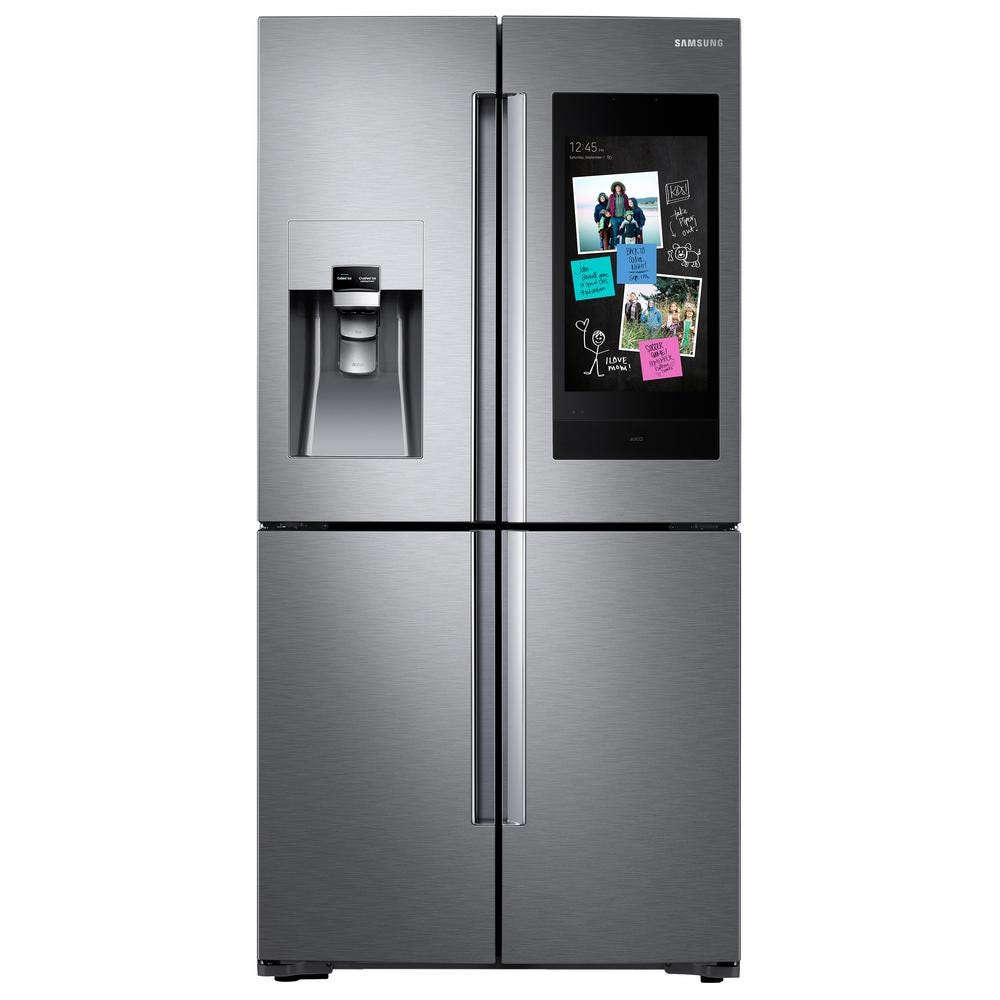The Samsung Smart Fridge–Genius?!
The Samsung Family Hub Smart Fridge:

On May 4th, 2016, Samsung introduced this gentle metallic creature to the world. Within hours, Frankenstein’s monster was alive, the Internet ablaze with criticism.
Some reviewers feared the fridge would invade their privacy; technology seemed foreign enough in the home, much less the kitchen. Others scoffed at the execution, citing the confusing UI and slow touchscreen response. And many onlookers–myself included–found the mere notion of a smart fridge so absurd that we flooded social media with thousands of memes.
Years later though, Samsung’s decision to invest in smart kitchen technology appears prescient. Researchers now predict the industry will grow at a 25% CAGR over the next decade. A third of that market belongs to refrigerators, which will grow at 13% until 2025. Samsung currently owns over 30% (and growing) of the premium French-door refrigerator market under which most smart fridges fall.

To understand the growth of smart kitchen appliances–and consequently, Samsung’s elite market positioning today–we must first analyze two main developments (without any of which the smart kitchen would be impossible):
The creation of the Internet of Things
The materialization of technology in the house
These periods will give us a good idea of the development of smart kitchen technology and the potential for future growth in the industry.
How the Samsung Smart Fridge came to exist.
In the early 1980’s, programmers at Carnegie Mellon connected a Coke vending machine to the Internet. Before leaving their desks, they could wirelessly check whether the machine (1) had a particular drink and (2) how long that drink was cooled. Their concept–linking objects to the Internet to enable access at a distance–became known as the Internet of Things (IoT for short).
While the foundations of IoT developed through the 1990s and 2000s, it took until 2010 for the new technology to universalize. From that point onwards, entrepreneurs could incorporate any object with an on/off switch into the IoT, which people commonly picture as a web:

Soon, everything from toy rabbits to self-driving cars became a part of the IoT. However, one area long remained exclusive to internet-connected technology: the home. This result partially explains the failure of the first smart fridge, which was expensive, clunky, and conceptually out-of-place.
In the 2010s though, technology entered the home. Smartphones, smart TV’s, smart doorbells, and more all became essential constituents of the smart home. Take Google’s strategy, for example. Google started in 1998 as an internet searching company. In 2006, Google acquired YouTube, a video streaming platform that inserted Google into the personal lives of millions worldwide. In the late 2000s and early 2010s, Google invested in a host of IoT devices, including Nest–a smart thermostat. Nest represented one of Google’s first steps in building a connected home. Now, the company is centering that project around its voice assistant Google Home:

Google’s strategy is only one piece of the general market trend. I created the below graphic to elucidate the transition from dumb to smart devices. In the 20th century, a few companies like Whirlpool, GE, and Honeywell managed a majority of appliances. However, with the creation of the Internet of Things, new technology companies took their spots, either by innovating within (like LG, Samsung) or by acquiring successful startups (like Amazon, Google with Ring, Nest).

This trend continues to this day, with the following general structure for the creation of a new IoT device:
Entrepreneur slaps internet connectivity onto an existing device.
He/she creates a proof of concept, demonstrates the existence of a market (or creates a market), and rides the following wave to sell devices.
Larger company acquires entrepreneur’s company.
He/she rides off into the sunset with millions of dollars.
While steps 1, 2, and 4 relate more to startups, step 2 is essential for all IoT devices; we can use it to situate the growth of the smart fridge. LG created a proof of concept back in 2000, but it could not find a market. By bringing technology into homes, Google and other large companies created the present market in the 2010s.
This leaves Samsung with both technology and customers ready. Hence, the natural creation of the Samsung Smart Fridge.
Is the Samsung Smart Fridge a good idea?
The smart kitchen appliance market faces a sharp adoption curve. Specifically, while the average middle class family has adopted the smartphone, the smart TV, and perhaps a virtual assistant, over 90% people do not own a smart appliance today. Let’s take a look into the Samsung Smart Fridge to understand three factors limiting its widespread adoption.
High Price: Samsung Smart Fridges start at $2199, while a standard fridge of the same size ranges from $800-1500.
Limited Lifespan: Like all technology, these fridges age with time. Unlike traditional fridges, smart fridges expire within five or so years. Samsung has not taken any steps to resolve this issue. Interestingly, they have moved in the opposite direction, prioritizing cloud-based apps that phase out past hardware within a few years.
Lack of Existing Smart Network: A Samsung Smart Fridge would make sense in an ecosystem of connected devices (even better if all Samsung). However, this adoption has not taken place.
To be fair, these issues plague all smart kitchen appliances, but for Samsung to capture the broad market, it needs to address these concerns. Then, and only then, can Samsung capitalize on the work tech has done in the last decade and become a dominant player in the modern kitchen.


